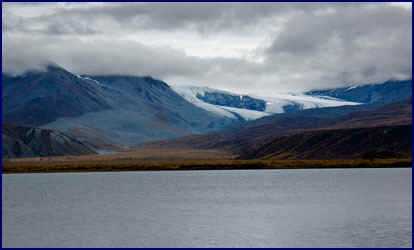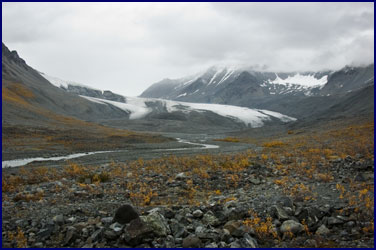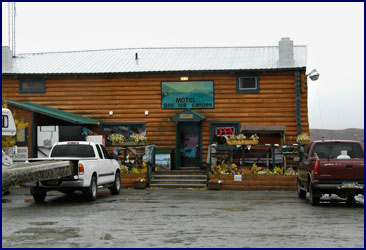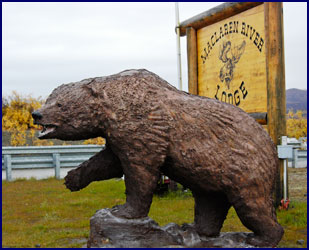|
Day
3: September 8
We were up at six - it was raining
lightly and just thinking about getting light.
We walked back to
Mud
Lake
, but arrived just in time to get a glimpse of the tail end of a
moose leaving. Still, it
was lovely to be by the lake at dawn; the loons were calling, ducks
were dipping into the water with bottoms up, and a pair of elegant
swans floated by imperiously. Two
immature bald eagles were flying in circles, seeming to play in the
air currents - Audi told us they are five years old before they get
their striking white head feathers.
We returned to the lodge and had
coffee with Audi and Jenny, and learned about the salmon we had seen
in the stream. These
were Sockeye salmon, and by the time they make it so far upstream
they are already dying; “Dead fish swimming” was the phrase
Jenny used to describe them. The
brilliant red color they display as they fight their way upriver is
actually the red pigment leached from their flesh; they are still
silver when they leave the ocean.
On their long journey they don’t stop to eat, and their
bodies start to decay. Once
they reach their destination, they spawn and then soon die.
By that point their meat is not salmon-colored, but a mealy
white; Jenny told us they are not good to eat in this stage, unless
you are a bear.
Audi gave us some great destination tips for the day.
We set out north on the
Richardson Highway
, and drove up the mountain to Isabel Pass.
Our rental car pulled severely to the left, and it shimmied
and shuddered any time we reached speeds over 55 mph, but there
weren’t too many sections of road where you could go that fast
anyway. As we slowly
climbed the pass, I felt the desire to pump my body back and forth
to keep the car moving while chanting, “I think
I can, I think I can.”
We stopped by
Summit
Lake
, a huge 320 foot deep lake at the top of the pass - it seemed odd
for there to be such a large lake at the top
of a mountain. The
tundra was clothed in red and gold, but at the higher elevation up
on the pass it appeared black; the blueberry bushes had lost their
leaves already, exposing the dark trunks and branches, and giving
the tundra an almost burned look.
|

Summit Lake, with the
Gulkana Glacier in the background.
|
We passed through Rainbow canyon, the road following the
river down between steep-sided mountains; you could easily see where
it got its name – both the vegetation and the rocky slopes
displayed a wide array of colors.
Two bald eagles soared above us, weaving in and out of the
mist. The road roughly
paralleled the Alaskan Pipeline, which the Milepost told us has
carried over 15 billion barrels of oil the 800 miles from the
oilfields near the Artic Ocean to the port of Valdez on the Gulf of
Alaska. It was quite
impressive to see; the pipe is about four feet in diameter, and is
supported by a framework of huge posts, allowing it to shift and
slide in its supports in the case of an earthquake.
Audi had given us directions for a little side trip; go past
Milepost 214 and take the turnoff to the right at the end of the
avalanche zone. We
turned on a small gravel road that appeared to dead end at the base
of a cliff after about 100 yards - but then we found an opening that
took us around behind the rock face.
We followed the small road as it wound back through a narrow
canyon. It was an
off-the-beaten-path kind of place that we would never have found
without Audi’s advice. The
further we went the rougher the route became; soon we were sweating
it as we drove over what amounted to a faint track among jagged
rocks and loose scree, our Dollar Rental Car gravel road restriction
foremost in our minds. We
were miles from nowhere; what on earth would we do if we punctured a
tire or oil pan?
We followed our hazardous route through a network of hidden
canyons, each leading to the next, until eventually we came out on a
hill overlooking a broad river valley.
We crossed several open fords, but finally came to one where
the water was too deep to attempt; we had to back up quite a ways to
find a place to turn around before returning to the highway.
Audi had suggested that we hike to the Gulkana Glacier; he
said that it was a challenging and interesting hike, and that a
surprise awaited us along the way there.
Sounded like fun.
When we had passed the entrance road
earlier on the way north we had enjoyed a good view of the glacier,
but when we returned for our hike the mists were thick around it,
hiding all but the lower portion from sight.
We drove over the gravel flats as far as the track would take
us - the way gradually became rough and impassable – then we
parked the car and walked.
We followed a narrow rocky path that
wound through the brush and over a hill to a small river; here we
discovered the ‘surprise’ that Audi had mentioned. A
swing bridge spanned the gorge formed by the swiftly flowing stream,
suspended above the water on slender cables.
It was long and narrow, and extremely spindly and unstable.
We had crossed swing bridges in
New Zealand
, but nothing nearly as rickety as this.
As we stepped out onto the bridge we immediately saw that
several planks were broken completely in two, and many others were
cracked through. With
each step the entire bridge vibrated and swayed - it was a
treacherous piece of work. Jineen
has no fear of heights and seemed to negotiate the span easily, but
I nervously shuffled across, strains of the Indiana Jones theme song
playing in my head, clutching the handrail cable for dear life and
expecting each plank I stepped on to break underfoot and pitch me
headlong into the cold river below.
Fortunately this didn’t happen, but the potential was
definitely there.
Our route took us along the glacial runoff stream, its chalky
white water rushing swiftly down the wide rocky valley. We
paralleled the stream, heading toward the glacier now barely
glimpsed through the mist ahead of us.
It was a barren landscape with no set trail to follow; we
picked our way over the rocks as we progressed slowly up the valley.
The solitude was complete; the only sound we could here was
the rushing of the stream. We
saw no people and no wildlife, just a few Dall sheep tracks and some
bear scat.
We seemed to walk forever without
getting any closer to the glacier.
Once again we experienced that deceiving Alaskan perspective;
it ended up being a three and a half mile hike each way, but from
where we had started the glacier had appeared much closer.
|

The Gulkana Glacier
|
When we finally reached the glacier, we were struck by how
huge it was; in the distance it has looked small, but now the face
of it towered high above us. The
lower portion appeared dirty; the ice was layered with gravel that
had slid down from the mountains above.
We were able to walk right up and actually put our hands on
the base of the glacier; it was granular ice, solid and hard to the
touch. The air was much
colder here. There were
caves where big chunks of the ice had broken out, and water was
running out of every crevice, a milky gray-white color. The
mist lifted so we could see a lot more of the glacier above, and a
hint of weak sunshine lightened the sky.
We sat near the base of the glacier
and lunched on trail mix. We
felt like we had somehow stepped back in time. Even
though we had left the highway in 2008, we were now in some
primordial setting that had existed since the beginning of time.
We could see no sign that any other humans existed.
Somehow the trip back seemed to pass
much faster. A sudden
rain came up when we were almost back to the car; we had packed rain
paints in our packs, but we were soaked before we had a chance to
put them on. Cold and
wet but very content, we headed back to Paxson.
We went a few miles up the
Denali Highway
to a high spot where we could see the Gulkana glacier from a
distance and had our Happy Hour.
We reflected on the fact that we hadn’t seen another person
all day.
But the day wasn’t over yet; we had scheduled to go on an
evening float trip. We
started out at 6:30 p.m. in a raft with six people, including Audi
and Jenny. We floated
down a small river with a moderate current; it was peaceful and
serene.
We
saw an assortment of wildlife, and Audi was able to tell us about
the different birds, fish and animals.
There were ducks, widgeons, green-winged teals, trumpeter
swans, and a bald eagle in a tree.
Thousands of salmon were fighting their way upstream to
spawn. Several muskrats
swam across in front of the raft, and a beaver passed close by.
A moose suddenly appeared on the shore, briefly pausing
before plunging into the water and splashing across in front of us,
then disappearing swiftly into the twilight.
We stopped on a sandy spit alongside the river, where Audi
showed us fresh bear tracks. It
was dark by the time we neared the end of the trip, paddling on flat
water. Jineen thought
she saw something big and dark by the edge of the water, but it
turned away quickly and vanished just as she glimpsed it, so we were
never sure what it was.
Day
4: September 9
We woke up to rain.
We had learned our lesson yesterday; from now on we would
just put our rain pants on when we got dressed in the morning and be
done with it. We had
some tea and bad coffee at the Paxson Roadhouse; Audi had described
it as ‘ordinary,’ but we could see now that he had been
generous.
The
Denali Highway
is a 135 mile gravel road; from Paxson it runs west to Cantwell.
Reading the Milepost, we learned that it was completed in
1957 to provide access to
Denali
National Park
. But the
Parks Highway
was paved from
Anchorage
to
Fairbanks
in 1972, and the
Denali Highway
was somewhat abandoned. Since
then it has been used mainly by hunters and fishermen to access the
back country, and by those who wish to see
Alaska
as it used to be, with wilderness in every direction.
It sounded like our sort of road.
We set out with great anticipation;
the
Denali Highway
was the centerpiece of our trip – don’t tell the Dollar Rental
Car people, but we planned to spend three days driving it.
On some of our trips in the past we have tried to cover a
little too much ground in order to see everything, but this time we
had avoided that; we wanted to be able to sit and stay awhile.
The roads in
Alaska
pass through some of the most beautiful countryside imaginable;
anyone who drives them is treated to spectacular views and fabulous
scenery. But we were
interested in more than that; we wanted to experience the hidden
places that you could easily drive by without ever knowing they were
there. The secret spots
where you might take some small path that winds through the brush
before opening up to incredible vistas that the average traveler
never sees. Places that
to appreciate them, you have to just sit and wait, and see what
comes. We wanted to
experience what the road passes by.
There was a dusting of white on the ridge tops from the night
before; our rain had fallen as snow at the higher elevations.
We saw swans on the lakes and bald eagles winging their way
alongside the highway. We
had been told that caribou might be migrating through the area, so
we kept a good eye out for them.
The Milepost gave us tips on the best spots to watch for
wildlife - we would stop alongside the road and sit, scanning the
vista with our binoculars (called ‘glassing’ in
Alaska
), searching for animals.
It
was 42 degrees and raining when we came to
Tangle
Lakes
. We hoped it would warm
up as the morning wore on. We
stopped at the inn for a breakfast of delicious pancakes, though not
sourdough.
Continuing
on, we explored the shores of
Tangle
Lake
- or at least as much as we could without getting out of the car.
The temperature was down to 39 now, and there was a steady
rain falling. We watched
trumpeter swans in flight, and continued west on the
Denali Highway
in search of caribou.
We
came to a likely viewpoint and parked by the side of the road.
Jineen’s eagle eyes spotted several tiny dots far in the
distance; we pulled out the binoculars to determine if they might be
caribou. As our
attention was riveted on the little specks across the valley, five
caribou suddenly burst out of the underbrush, practically running us
down as they dashed across the road right in front of us.
I barely had time to grab my camera for some action shots as
we watched them move swiftly through the bushes and disappear into
their surroundings.
Further on, we saw several more groups of caribou in the
distance, lying down huddled against the rain, or silhouetted
against a far lake as they walked along its shore.
OK, we thought, we’ve checked off caribou; now its time for
a good close view of a moose.
We had lodging booked for the next two nights at the Crazy
Dog Kennels and Cabins at milepost 42.
We arrived early in the afternoon, but nobody was around and
a chain was across the entrance.
There was a note on the gatepost directing us to the 2nd
cabin, the one with blue curtains, and saying that the owners would
be back about four o’clock.
By then it was 36 degrees and
raining hard and we were a bit cold, so we thought we would go in to
the cabin for a while to warm up.
We found the one with the blue curtains (there were only two
to choose from), perched on the top of a steep slope, overlooking a
slag pond. On entering,
we found that we were to experience the real authentic rustic
Alaska
– in other words, we were roughing it.
There was no bathroom, no heater, no lights, and in fact no
electricity. When I made
the booking I had been told that it had no shower, but I had assumed
it would have a heater. It
had never occurred to me that I needed to ask about electricity.
In the corner was an ancient wood stove.
No wood in it. No
fire. No fireplace
poker. There was,
however, a dead stuffed magpie in the outhouse, and a similarly
preserved raven in the corner of the cabin - I kept expecting it to
quoth “nevermore.” We
started to have a new appreciation for the name ‘Crazy Dog.’
The rain had finally let up and the temperature rose to a
balmy 44 degrees, so we went hiking.
Once again following tips from Audi, we drove back a few
miles to the McLaren Ridge, which roughly paralleled the
Denali Highway
. We made our own path,
scrambling up the steep slope to the top; it was further than it
looked from the road, as are most things in
Alaska
.
We walked around on the top of the
ridge. The tundra was
soft and squishy underfoot, but strewn with rocks; there was no
trail, and the going was slow. We
saw a marmot and a ptarmigan, but otherwise we were utterly alone.
The rolling land stretched out before us, looking somewhat
empty and barren, and we could see a distant river valley off the
far side of the ridge. We
discovered a cairn of stones that some traveler before us had placed
there on the top. The
Denali Highway
was stretched out below us, empty of cars - otherwise we could see
no sign of civilization.
Returning
to the Crazy Dog Kennels, we met Zoya, one of the owners.
She and her partner John were both sled dog racers; Zoya told
us she had raced in the Iditarod, completing it in 42 days.
They had a large kennel of sled dogs; we could see them
chained to their doghouses, as seems to be common in
Alaska
. I had envisioned the
racing dogs as being purebred Huskies or Malamutes, but most of them
seemed to be mixed breeds, smaller and with thinner coats than I
would have expected.
We had dinner at the McLaren Lodge, a rustic log building
with a large plaster bear statue out front, a huge stone fireplace
in the dining room, and a homey atmosphere.
The food was excellent, we had the fresh salmon.
We immediately fell in love with the place; the owners, Alan
and Susie, were extremely nice, and there was a sense of camaraderie
among the other diners and the staff that was hard to beat.
We had been out of cell phone range for several days, and as
there were no land lines, they let us use the ‘radio phone’ to
call home – a great solution, as long as you didn’t mind
everyone in the restaurant hearing both sides of the conversation.
|


McLaren Lodge
|
We were pleasantly surprised at how reasonable the meal
prices were; researching the trip I had read that we should expect
dining prices to be high in
Alaska
, since everything has to be shipped long distances, and the people
need to earn enough money during the tourist season to make it
through the cold hard winters. Fair
enough. But we found
throughout our trip, with very few exceptions, that the food was
very good and the prices were no higher than we would expect to pay
at home.
After dinner, we drove up to 50 Mile
Lake
, which as the name suggests, is a lake at milepost 50.
It is actually a serious of about eight lakes, stretching for
several miles along either side of the road, with streams, marshes,
and small rivers connecting them.
We were looking for moose; the folks at the lodge had told us
that this was one of their favorite feeding grounds, and they could
often be seen there in the evenings.
Apparently we weren’t the only ones with this information -
there were hunters everywhere. We
saw swans, ducks, and eagles, and dozens of beaver dams and lodges
in the network of streams and lakes.
A camouflaged hunter in a small canoe floated near the shore.
We drove up and down the area,
stopping often to ‘glass’ in search of animals.
After going to the furthest lake, we worked our way back
toward the first one again. Catching
some movement in the water, I raised my binoculars for a look, and
Jineen asked if it was the hunter in the canoe again.
“No,” I said, “It’s a beaver, swimming along pulling
a tree.” Jineen stared
at me incredulously but I wasn’t joking - we sat and watched the
busy little guy at work for a long time.
He would cut a small willow tree, drag it into the water,
swim across the lake with it, and then dive under the surface,
pulling the tree with him into his lodge, presumably to store it as
food for the winter.
We headed back to the Crazy Dog,
where it dawned on us that it may have been a mistake to wait until
it was pitch dark to try and get a fire going.
There was a flashlight type Coleman lamp in the room, but the
batteries were dead. Fortunately
Jineen knew how to operate a wood stove, but fumbling around in the
dark trying to figure out the damper may not have been the best of
plans. But eventually
she got the fire going, and we opened a bottle of wine for a late
happy hour. The wine was
nicely chilled, but then so were we. We
were starting to regret not rooming at the McLaren Lodge.
|